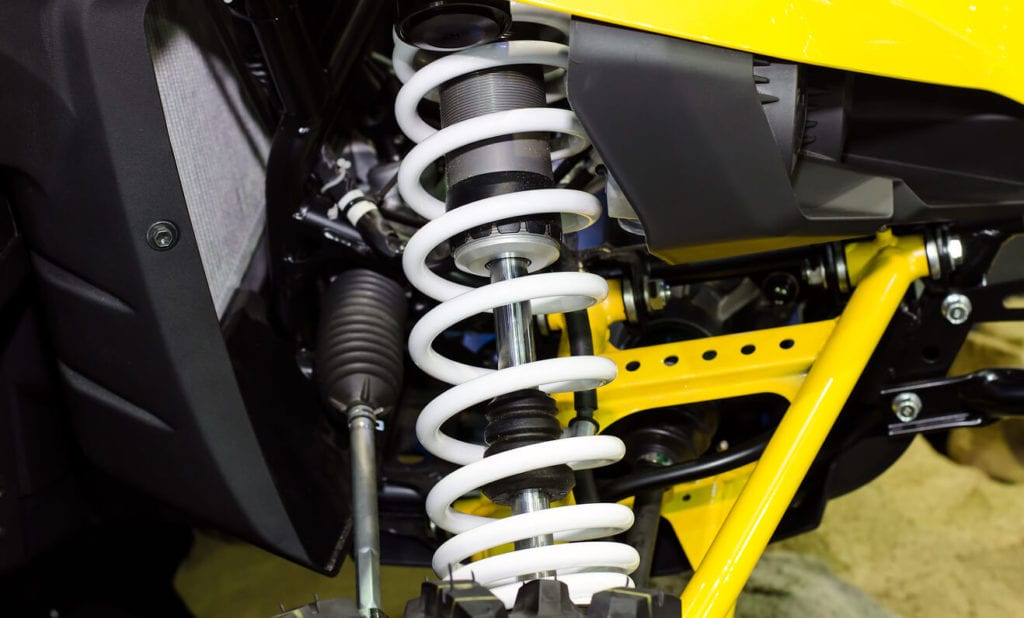 Struts and shocks, as part of your suspension system help keep the ride in your car a comfortable one. If you thought going over a dirt road with shocks was bumpy, imagine driving on one without them! Struts and shocks are meant to dampen the energy that is created when a vehicle travels over a bump. Their primary job is to control the movement of springs from too much up and down movement. After many miles and multiple reductions of bumpiness, over time struts and shocks begin to lose their effectiveness. At Sun Auto Service, we get lots of questions about struts and shocks. We’ve compiled our most frequently asked questions about struts and shocks:
Struts and shocks, as part of your suspension system help keep the ride in your car a comfortable one. If you thought going over a dirt road with shocks was bumpy, imagine driving on one without them! Struts and shocks are meant to dampen the energy that is created when a vehicle travels over a bump. Their primary job is to control the movement of springs from too much up and down movement. After many miles and multiple reductions of bumpiness, over time struts and shocks begin to lose their effectiveness. At Sun Auto Service, we get lots of questions about struts and shocks. We’ve compiled our most frequently asked questions about struts and shocks:
Q: What do struts and shocks do?
A: The struts on a car are meant to keep the vehicle balanced and flat on the road and limit vertical motion from the springs. Struts and shocks control the movement of the suspension to control the ride and keep tires in contact with the road. Struts, as part of the suspension system, are also meant to keep the body of the vehicle off the ground in addition to control the ride. While their task is the same, the main difference between the two is that shocks are an independent component while struts are a structural part of the vehicle.
Q: How do struts and shocks work?
A: Struts and shocks do not absorb the energy generated from traveling over a bumpy surface. Instead, the kinetic energy is converted into heat, or thermal energy, then dissipates into the air. Once the spring is activated, from traveling over a bump, pothole, etc., it bounces past its attached position and continues to undulate until the energy is completely dispelled.
Q: Where are struts and shocks located?
A: Struts and shocks are mounted between the upper and lower control arms, near the axle and frame of the rear of the vehicle. Vehicles may have struts or shocks or a combination of both. Of course, each vehicle may vary from model to model on its engineering.
Q: How can I tell if my car has struts or shocks?
A: Each vehicle is different; however you may be able to determine what your vehicle is equipped with simply by looking at it. Shocks resemble a pump and are most often mounted in an upright position. Struts are more difficult to see as they are most often installed in the suspension and can be tucked away. They are easily identified, though, as they look as if they are an extension of the wheel. For confirmation, always refer to your owner’s manual or seek the opinion of an experienced, certified automotive technician.
Q: When should I replace shocks and struts?
A: Manufacturers of shocks and struts recommend replacement every 50,000 miles. In 50,000 miles time, you’ve driven over numerous potholes, speed bumps, and other road conditions. Plus, by this time, the shocks on the vehicle have likely oscillated 88 million times.
Q: How long do shocks and struts last?
A: How long your shocks and struts last depend vastly on your driving habits and conditions. If you frequently drive on unpaved or rough roads, tow heavy loads, or otherwise drive aggressively, you can expect to replace them sooner rather than later. However, with average driving every 50,000 miles is ideal.
Q: How do I know if my struts or shocks are bad?
A: The most common symptoms that indicate your struts or shocks are in need or replacement include:
- Poor ride quality – tires may lose contact with the road and produce an uncomfortable, bumpy ride.
- Leaking oil – a piston within the tube of a strut or shock is filled with oil to ease dampening kinetic energy. Over time seals may begin to rupture or the oil breaks down from use.
- Difficulty steering – Swaying, leaning, noises while turning, or difficulty turning the steering wheel.
- Uneven tread wear – Poor suspension as a result of damaged struts or shocks can cause the tread on tires to begin cupping.
- Nose dive or squatting – Due to difficulty in supporting the vehicle’s weight, when braking, the vehicle’s front end may dip forward, or the rear will squat downward.
Q: Why should I replace my shocks or struts?
A: Ride quality and safety are the two most important reasons you should replace your struts and shocks as needed. Once replaced, you’ll notice a smoother, more comfortable, and quiet ride. Additionally, you’ll notice an improvement on cornering in the vehicle. Just like when the vehicle was new, the cornering will increase control, help with stopping distance, and increase driver confidence in emergency situations.
Q: My struts/shocks aren’t leaking. Why should I replace them?
A: You shouldn’t wait for problems to become obvious before replacing your struts or shocks. Struts and shocks help prevent long term damage to your car. Because everything in a car is joined together in some way, a minor problem within the suspension system can intensify and lead to troubles elsewhere on the vehicle. Furthermore, the dampening effect of the shocks and struts decline enough to impact ride handling, however, you may not notice the change as the degradation happens gradually.
